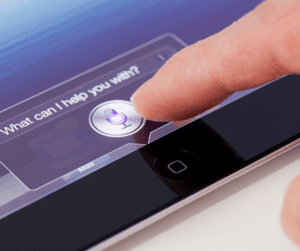We’ve all heard of Siri, Alexa, and Bixby – and as these artificially intelligent (AI) assistants worm their way into our hearts, new avenues for voice marketing can be explored.
A marketing strategy is used to reach an audience through voice-enabled devices, powered by voice assistants to meet their needs and expectations, by adjusting the brand messaging based on the context of the query.
Well, that’s the boring version…
Voice marketing was born with radio–recorded marketing snippets, which we have come to know and hate for interrupting our groove when listening to our favourite station, is just one form of voice marketing. You may be familiar with podcasting, flash briefing, and branded content.

We hear voice marketing in our everyday lives, whether it be on the TV, the radio, our devices… Yes, those voice assistants are in the same basket.
For a quick overview, Google rolled out the option to double-tap the home button on our phones to simply talk to the device instead of inconveniently typing. A game-changer for the texting generation whom we judge from traffic light to traffic light.
Apple’s Siri added a bit more flavour to the option which was a quirky, witty, and sometimes sarcastic programmed personality. For those of you with Apple devices, try asking Siri to divide by zero and listen to what she has to say…
For online searching and conversations with your phone, Google and Apple captured the market. Samsung, in playing catch-up, enabled the Bixby voice assistant with a unique perspective on wine, a deeply rooted grasp on the internal device settings, and integrated her into the camera.
Alexa, from Amazon, changed the game. Her programming allows her to make online orders on your behalf, control your smart appliances, and so much more.

There is no doubt that our voice assistants are easily smarter than we are – and as ingenious and awesome as they may be, we realised early on that this opens a whole new level when it comes to voice marketing.
There are three main types:
Sonic branding – This is the strategic use of music and sound to reinforce brand recognition. It’s the audio version of visual branding. It’s what customers associate with the brand when they hear a sound. For instance, the Apple start-up sound or McDonalds catchphrase, “I’m Lovin’ it”.
Recorded audio – These are those podcasts and flash briefings. Due to its ability to be listened to anywhere, the growth is enormous. Check out the stats a little later in this article.
Voice search optimisation (VSO) – The future of search is moving towards voice, and valuable content will be put in front of the consumer. Remember our mention of Alexa, Bixby, and Siri? This is a new form of SEO (search engine optimisation), except for voice-related content and like traditional SEO, it is becoming vital for business success and ROI.

More than one-third of the total US population aged 12 and over (104 million) are consuming podcasts monthly, representing 16% year-over-year growth. For more stats, please click here.
Voice marketing isn’t going to go away. It’s on the rise and will continue its trajectory for the foreseeable future as these trends that we have noticed are on the rise in the UK, Europe, Africa, and the rest of the world as well.

The benefits of voice marketing:
So, do yourself a favour and help your brand get heard (excuse the pun).
Follow this guide to get started:
Voice marketing brings new opportunities for your brand. We hope after reading this you have a clearer understanding of what voice marketing is, why it’s important, and how to get started.